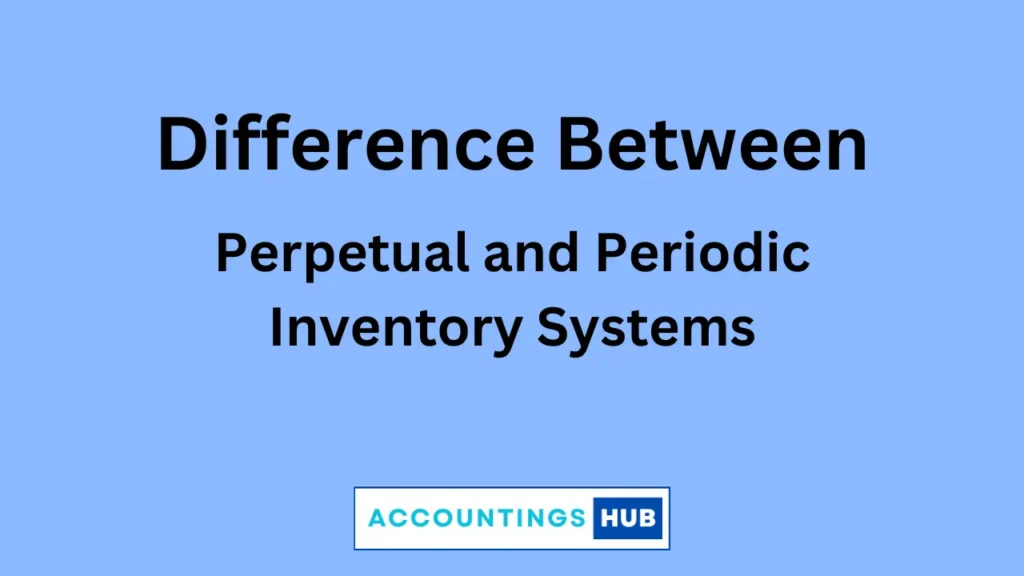The two main methods of recording inventory to calculate the cost of sales are Perpetual and Periodic methods.
Each method uses a ledger account for inventory, but these have different roles. An entity may use the periodic system in its general ledger and use a different computer system outside of its general ledger to track the flow of goods in and out of inventory.

| Periodic Inventory System | Perpetual Inventory System |
| Inventory and cost of goods sold are not updated continuously. Instead, purchases are recorded in the Purchases account and each sale transaction is recorded via a single journal entry. Thus, the cost of goods sold account does not exist during the accounting period. It is determined at the end of the accounting period via a closing entry. | Inventory and cost of goods sold are updated continuously on each sale and purchase transaction. Some other transactions may also require an update to the inventory account, for example, a sale/purchase return. Purchases are directly debited to the inventory account whereas for each sale two journal entries are made: one to record the sale value of inventory and the other to record the cost of goods sold. The purchases account is not used in the perpetual inventory system. |
| Purchases and purchase return accounts are maintained. | Purchase and Purchase return accounts are not required. |
| Any loss of inventory is automatically dealt with and does not require a special accounting treatment. However, in this way, losses may go unnoticed as well. | Any loss detected by comparing physical inventory count and perpetual records is to be recorded in the inventory account. Most losses are identified in this way (see below). |
| This system is suitable for large-size items or low-value inventory. | This system is suitable for high-value inventories or where inventory movements are frequent. |
POSSIBLE CAUSES OF DIFFERENCE PERPETUAL AND PERIODIC INVENTORY
Possible causes of difference between the balance on the inventory account and the physical inventory counted include the following.
- Theft of inventory.
- Incorrect posting of inventory receipts or issues (to different item categories).
- Damage to inventory with failure to record that damage.
- Failure to record a receipt.
- Failure to record an issue.
| JOURNAL ENTRIES | |||
| Periodic Inventory System | Perpetual Inventory System | ||
| Opening inventory | |||
| Dr. Cost of Sales Cr. Inventory | b/d balance of inventory account | ||
| Purchases | |||
| Dr. Purchases Cr. Payables / Cash | Dr. Inventory Cr. Payables / Cash | ||
| Freight or carriage or other direct costs | |||
| Dr. Carriage in / production costs Cr. Payables / Cash | Dr. Inventory Cr. Payables / Cash | ||
| Settlement discount on purchases | |||
| Dr. Payables Cr. Purchases / Discount received | Dr. Payables Cr. Inventory | ||
| Returns to suppliers | |||
| Dr. Payables / Cash Cr. Purchases returns | Dr. Payables / Cash Cr. Inventory | ||
| Sales | |||
| Dr. Receivables / Cash Cr. Sales | Dr. Receivables / Cash Cr. Sales | ||
| Dr. Cost of Sales Cr. Inventory | |||
| Returns from customers | |||
| Dr. Sales returns Cr. Receivables / Cash | Dr. Sales returns Cr. Receivables / Cash | ||
| Dr. Inventory Cr. Cost of sales | |||
| Abnormal loss | |||
| Dr. Abnormal loss Cr. Purchases | Dr. Abnormal loss Cr. Inventory | ||
| Drawings | |||
| Dr. Drawings Cr. Purchases | Dr. Drawings Cr. Inventory | ||
| Free samples / Charity | |||
| Dr. Marketing expense / Charity expense Cr. Purchases | Dr. Marketing expense / Charity expense Cr. Inventory | ||
| Inventory used to construct non-current assets | |||
| Dr. Non-current assets Cr. Purchases | Dr. Non-current assets Cr. Inventory | ||
| Normal loss | |||
| No entry required | Dr. Cost of Sales Cr. Inventory | ||
| Write down to NRV – identified BEFORE final adjustment of closing inventory | |||
| No entry required | Dr. Cost of Sales Cr. Inventory | ||
| Closing inventory (year-end adjustment) | |||
| Dr. Inventory Cr. Cost of Sales | The closing balance of inventory account. | ||
| Write down to NRV – identified AFTER final adjustment of closing inventory | |||
| Dr. Cost of Sales Cr. Inventory | Dr. Cost of Sales Cr. Inventory | ||
| All entries are recorded at cost except entry of write down to NRV and entries to sales and sales returns account which are based on selling price. | |||
Frequently Asked Questions
What is a perpetual inventory system?
Every purchase and sale of goods is automatically and instantly recorded in a perpetual inventory system, which is used to maintain and record stock levels. The software in this system tracks real-time changes in inventory levels with each transaction that occurs.
What are the examples of perpetual inventory systems?
Every transaction involving the cost of goods is promptly recorded as it happens when there is a perpetual inventory. Consider grocery stores as an example. The system updates the inventory levels in the database each time a product is purchased and scanned.
What are the three methods of periodic inventory?
There are three methods to calculate the cost of inventory: Weighted Average Cost, LIFO, and FIFO. The first inventory to be purchased is also the first to be sold, according to FIFO. This method of inventory costing is chronological.
What are the advantages of a periodic inventory system?
Periodic inventory accounting has several advantages, prominent among them being its ease of use and low cost of implementation. This is because it need not happen frequently. It doesn’t need sophisticated software, or even more workers, which is especially beneficial for companies with low sales volumes.
